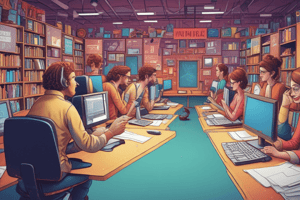Podcast
Questions and Answers
What are the three main elements involved in the communication process?
What are the three main elements involved in the communication process?
- Encoder, Medium, Decoder
- Sender, Message, Receiver (correct)
- Communicator, Feedback, Environment
- Source, Content, Audience
Which of the following best describes the role of the sender in communication?
Which of the following best describes the role of the sender in communication?
- The one who receives and acts upon the message
- The person who confirms the message was understood
- The source that generates and conveys the message (correct)
- The medium used to transmit the message
What occurs after the receiver understands and acts upon the message?
What occurs after the receiver understands and acts upon the message?
- The sender must resend the message
- The message is permanently recorded
- The communication process is considered incomplete
- Feedback is provided to improve future communication (correct)
Which of the following is NOT considered a medium of communication?
Which of the following is NOT considered a medium of communication?
What is a barrier to effective communication?
What is a barrier to effective communication?
Why is communication critical to the directing function of management?
Why is communication critical to the directing function of management?
How is a message typically encoded before being sent?
How is a message typically encoded before being sent?
What role does feedback play in the communication process?
What role does feedback play in the communication process?
What is proxemics primarily concerned with?
What is proxemics primarily concerned with?
Which of the following examples illustrates proxemics?
Which of the following examples illustrates proxemics?
What defines public communication?
What defines public communication?
Which option is a medium of mass communication?
Which option is a medium of mass communication?
How does mass communication influence people?
How does mass communication influence people?
What influence do mass communications have on political behaviors?
What influence do mass communications have on political behaviors?
What restriction can affect mass communication?
What restriction can affect mass communication?
What is a potential negative impact of mass communication?
What is a potential negative impact of mass communication?
What is the primary function of communication channels in a company?
What is the primary function of communication channels in a company?
Which communication method is considered most effective for internal communication?
Which communication method is considered most effective for internal communication?
What is a limitation of the Linear communication model?
What is a limitation of the Linear communication model?
How does the Interactive model of communication differ from the Linear model?
How does the Interactive model of communication differ from the Linear model?
What defines the Transactional model of communication?
What defines the Transactional model of communication?
Which aspect of vocal communication significantly affects the message's interpretation?
Which aspect of vocal communication significantly affects the message's interpretation?
What distinguishes non-vocal communication from vocal communication?
What distinguishes non-vocal communication from vocal communication?
What is the main purpose of signals in communication?
What is the main purpose of signals in communication?
How are symbols used in communication?
How are symbols used in communication?
What role do gestures play in communication?
What role do gestures play in communication?
What is an example of non-verbal communication?
What is an example of non-verbal communication?
Which communication model is least likely to allow for interaction between parties?
Which communication model is least likely to allow for interaction between parties?
In what way do non-vocal elements enhance communication?
In what way do non-vocal elements enhance communication?
What is the main role of communication in management?
What is the main role of communication in management?
Which of the following describes vertical communication?
Which of the following describes vertical communication?
How can informal communication negatively impact an organization?
How can informal communication negatively impact an organization?
What is an example of upward communication?
What is an example of upward communication?
Which factor can act as a barrier to effective communication?
Which factor can act as a barrier to effective communication?
What defines horizontal communication in an organization?
What defines horizontal communication in an organization?
What role does proper communication play in employee motivation?
What role does proper communication play in employee motivation?
Where does informal communication typically occur?
Where does informal communication typically occur?
Which of the following is NOT a type of formal communication?
Which of the following is NOT a type of formal communication?
How can the organizational structure impact communication?
How can the organizational structure impact communication?
What is NOT an example of downward communication?
What is NOT an example of downward communication?
Which barrier can arise from emotional states during communication?
Which barrier can arise from emotional states during communication?
What type of communication occurs when information circulates informally within an organization?
What type of communication occurs when information circulates informally within an organization?
What is a potential positive aspect of informal communication?
What is a potential positive aspect of informal communication?
Flashcards
Communication
Communication
The process of creating and sharing ideas, information, views, facts, and feelings between individuals or groups.
Sender
Sender
The person who creates and sends a message.
Message
Message
The idea, information, or feeling being conveyed.
Encoding
Encoding
Signup and view all the flashcards
Medium
Medium
Signup and view all the flashcards
Decoding
Decoding
Signup and view all the flashcards
Receiver
Receiver
Signup and view all the flashcards
Barriers
Barriers
Signup and view all the flashcards
Communication Channels
Communication Channels
Signup and view all the flashcards
Digital Communication Platforms
Digital Communication Platforms
Signup and view all the flashcards
Face-to-Face Communication
Face-to-Face Communication
Signup and view all the flashcards
Written Communication
Written Communication
Signup and view all the flashcards
Linear Model
Linear Model
Signup and view all the flashcards
Interactive Model
Interactive Model
Signup and view all the flashcards
Transactional Model
Transactional Model
Signup and view all the flashcards
Vocal Communication
Vocal Communication
Signup and view all the flashcards
Non-Vocal Communication
Non-Vocal Communication
Signup and view all the flashcards
Signals
Signals
Signup and view all the flashcards
Signs
Signs
Signup and view all the flashcards
Symbols
Symbols
Signup and view all the flashcards
Icons
Icons
Signup and view all the flashcards
Gestures
Gestures
Signup and view all the flashcards
Why is communication crucial for management?
Why is communication crucial for management?
Signup and view all the flashcards
How does communication help managers manage subordinates?
How does communication help managers manage subordinates?
Signup and view all the flashcards
What is formal communication?
What is formal communication?
Signup and view all the flashcards
Describe vertical communication.
Describe vertical communication.
Signup and view all the flashcards
What is horizontal communication?
What is horizontal communication?
Signup and view all the flashcards
What is informal communication?
What is informal communication?
Signup and view all the flashcards
What are the benefits and risks of informal communication?
What are the benefits and risks of informal communication?
Signup and view all the flashcards
What is unofficial communication?
What is unofficial communication?
Signup and view all the flashcards
What are communication barriers?
What are communication barriers?
Signup and view all the flashcards
Explain semantic barriers to communication.
Explain semantic barriers to communication.
Signup and view all the flashcards
How do emotional barriers affect communication?
How do emotional barriers affect communication?
Signup and view all the flashcards
How can organizational structures create communication barriers?
How can organizational structures create communication barriers?
Signup and view all the flashcards
Explain personal factors as communication barriers?
Explain personal factors as communication barriers?
Signup and view all the flashcards
Why is effective communication important for organizations?
Why is effective communication important for organizations?
Signup and view all the flashcards
Proxemics
Proxemics
Signup and view all the flashcards
Mass Communication
Mass Communication
Signup and view all the flashcards
Public Communication
Public Communication
Signup and view all the flashcards
Visual Communication
Visual Communication
Signup and view all the flashcards
Censorship
Censorship
Signup and view all the flashcards
Influence of Mass Communication
Influence of Mass Communication
Signup and view all the flashcards
Political Communication
Political Communication
Signup and view all the flashcards
Interpersonal Communication
Interpersonal Communication
Signup and view all the flashcards
Study Notes
Improving Communication Effectiveness
-
Identify and address barriers: Communication barriers can stem from language differences, emotional states (sender/receiver), organizational factors (structure, rules), or personal biases. Managers must proactively identify and mitigate these factors.
-
Clear Encoding and Decoding: Use clear language, avoid jargon, and ensure the message is interpreted correctly by the receiver. Ensure the message is translated and interpreted accurately.
-
Effective Message Transmission: Choose the appropriate communication channel (oral, written, digital) to facilitate and maximize message clarity. Consider the recipient's preferred method.
-
Two-way Communication: Fostering interaction and feedback loops enhances understanding and mutual respect between individuals and groups, thus minimizing misunderstandings.
-
Employ Diverse Channels: Leverage a mix of formal (vertical, horizontal) and informal (grapevine) communication channels to maximize reach and clarity.
-
Consider Nonverbal Communication: Recognizing and interpreting nonverbal cues (body language, gestures) is crucial to ensure complete interaction understanding.
-
Active Listening: Encourage active listening and engagement from receivers to enhance comprehension and reduce misinterpretations.
-
Emotional Intelligence: Effective communication demands emotional intelligence from all involved parties. Sender and receiver must manage their respective emotional states to foster clarity in message delivery and reception.
Communication Models
-
Linear Model: A one-way communication process, commonly used in mass media. Sender transmits a message through a channel to a receiver, with no immediate feedback.
-
Interactive Model: A two-way communication process that includes feedback loops. Receiver offers a response, transforming original sender into receiver. This enhances interpersonal exchange. Common example: phone calls.
-
Transactional Model: A dynamic model where the sender and receiver exchange messages simultaneously. Communication builds shared meaning among participants from similar backgrounds.
Types of Communication in Organizations
-
Formal Communication: Flows through official organizational channels (upward, downward, horizontal). Primarily written or spoken, documented for records.
-
Informal Communication: (Grapevine) Spreads beyond formal channels, often rapid but prone to distortion and rumor. Can provide valuable information but necessitate careful evaluation.
-
Unofficial Communication: Employee interaction outside of work, including social gatherings. Management awareness of this channel can provide valuable insight.
-
Digital Communication: Companies increasingly use online platforms for internal communication, benefiting from efficiency and interconnectedness.
-
Face-to-Face Communication: Maintains importance for nonverbal cues, essential for complex situations, particularly within organizations.
-
Written Communication: Critical for policies, instructions, and external communication with customers, vendors.
Mass and Public Communication
-
Mass Communication: Dissemination of messages to large audiences via media platforms (print, digital, broadcast). Can shape attitudes/behavior but also prone to manipulation.
-
Public Communication: Presentation or sharing information to a wider audience (public speaking). Often under some control and regulation.
Studying That Suits You
Use AI to generate personalized quizzes and flashcards to suit your learning preferences.




